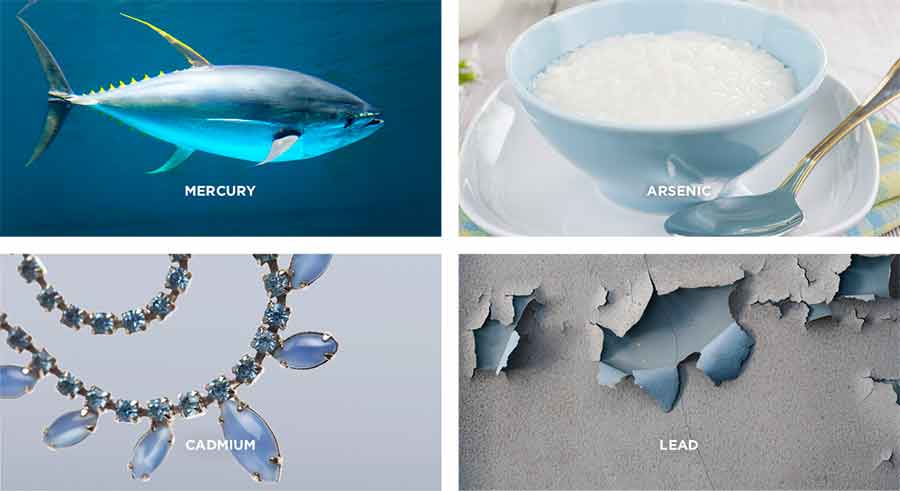Metals are essential for many uses, but some, such as mercury, arsenic, cadmium, and lead, can cause health harm. Fetuses and young children are particularly susceptible.
What are they?
Mercury, arsenic, cadmium, and lead are elements that occur naturally in the earth’s crust. Mining and smelting, fossil fuel combustion, industrial processes, and the use and disposal of products containing them have led to widespread environmental contamination and human exposure and health harm.
Where are they found?
Mercury
Coal burning plants can release mercury into air and water. The bacteria in bodies of water convert it into the more toxic methylmercury. Then, methylmercury is taken up by and concentrated in fish, with levels increasing up the food chain. Eating long-lived fish such as tuna is the major source of mercury exposure in humans. Other sources include some imported face creams, silver-colored dental fillings, glass thermometers, barometers, and fluorescent lights.
Arsenic
Major sources of arsenic exposure are drinking water and food. Arsenic is naturally occurring in some bedrock and can leach into drinking water. Also, arsenic from pesticides can be taken up from contaminated soil into food crops and produce. Foods such as rice, mushrooms, apples, and grapes can absorb arsenic from contaminated water and soil. Rice products (like infant cereal) have the highest amount of inorganic arsenic, which is the more toxic form. Inorganic arsenic is also found in pressure-treated wood used for outdoor structures manufactured before 2004, some drinking water sources, and cigarette smoke.
Cadmium
Cadmium is found in cigarette smoke, certain foods (shellfish, leafy vegetables, potatoes, grains, legumes), metal costume jewelry and charms, rechargeable batteries (labeled NiCd or NiCad), metal plating and solder, and some decorative paints used on glassware and pottery.
Lead
The major sources of exposure to lead are drinking water and peeling paint and dust in and around homes built before 1978. Lead can leach into water from plumbing and fixtures (common in plumbing before 1986) that are either made of lead or have lead solder, especially when the water is acidic. Lead can also be found in improperly made or deteriorating dishware and cookware, toys and costume jewelry, imported or recycled vinyl products, and lipstick.

What are the health concerns?
Exposure to mercury, arsenic, cadmium, and lead in the womb or in early childhood can harm brain development, leading to learning and behavioral problems. In adults, each metal is associated with increased cancer risk. Mercury and arsenic are associated with adverse effects on the nervous and cardiovascular systems. Cadmium is associated with lung and kidney damage as well as weakened bones. Lead can cause high blood pressure, miscarriages, stillbirth, infertility, and decreased kidney and brain function.
How are we exposed?
People are exposed to these metals through eating and drinking contaminated food and drinking water, ingesting and inhaling dust, inhaling cigarette smoke, and using certain products (listed above). In pregnancy, mercury, arsenic, cadmium, and lead cross the placenta and fetal blood-brain barrier during critical windows of brain development. Infants are further exposed through breastfeeding. Young children typically have higher exposure to metals because they consume more food in relation to their body weight, put their hands and toys in their mouths, and absorb metals more readily than adults.
What are the environmental concerns?
As they are chemical elements, these metals cannot be broken down, leading to accumulation in ecosystems. When released into the air, they can travel long distances before falling on land or surface waters. Because of their persistence and potential for long-range transport, industrial emissions of metals affect even the most remote regions.
The accumulation of methylmercury in fish has led to decreased reproduction rates in some fish-eating birds and other animals. Arsenic can harm aquatic organisms and reduce crop yields. Cadmium accumulates in plants, affecting the health of herbivorous mammals. Elevated lead in the environment can result in decreased growth and reproduction rates in plants and animals as well as and neurological effects in vertebrates.
What should be done to reduce exposure?
Despite significant decreases in exposure due to technological improvements and reduced usage in some products and industrial processes, these metals continue to pose health and environmental risks. For example, blood lead levels in U.S. children have declined by 90% since the mid-1970s from the elimination of lead in gasoline and paint. However, many in the U.S. are still exposed to lead through paint dust in housing built before 1978 and drinking water service lines made from lead, lead solder, or plumbing materials that contain lead. Further phase outs, abatement programs, emission regulations, cleaner technologies, and proper disposal practices are necessary to reduce metal contamination.

